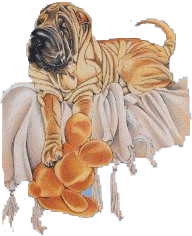|
|
|
|
|
Cushings
Syndrome/Disease |
||
|
The adrenal glands produce several vital substances which regulate a variety of body functions and are necessary to sustain life. The most widely known of these substances is cortisol. Either excessive or deficient production of these substances may be life-threatening.
How does this
disease occur? 1. Pituitary gland tumour The most common cause of Cushing's Disease (85% of all cases) is a tumour of the pituitary gland. The tumour may be either benign or malignant. The tumour causes the pituitary to overproduce a hormone which stimulates the adrenal glands. Excessive cortisol secretion results. The tumour may be either microscopic or quite large. Depending on the size of the tumour, the presence of signs other than Cushing's will be variable. Generally, if the activity of the adrenal gland can be controlled, the dog will live a relatively normal life. Unfortunately, this is sometimes not the case. However, many dogs with this form of Cushing's Disease can live normal lives for many years as long as they take their medication and stay under close medical supervision. Growth of the pituitary tumour would give the patient a less favourable prognosis. 2. Adrenal gland tumour Cushing's Disease may be the result of a benign or malignant tumour of the adrenal gland. If benign, surgical removal cures the disease. If malignant, surgery may help for a while, but the prognosis is less favourable than for a benign tumour. 3. Iatrogenic Cushing's Disease - this term describes the cases of Cushing's Disease that are caused by the excessive or prolonged administration of synthetic corticosteroids used for treating other diseases, (skin disease, for example). This may occur following the use of oral or injectable steroids. Occasionally use of ointment containing cortisone or its derivatives over a long period of time can result in excessive intake due to absorption through the skin or eyes or to the dog licking the product.
What are the
clinical signs?
How is it
diagnosed?
What are the treatment options?
1. Pituitary
Tumour
Treatment of the pituitary-dependant Cushing's Disease requires
administration of tablets. A chemotherapy-type drug is generally used
called Lysodren (Mitotane-OPPD). This is a human drug that has to
be imported into the U.K. from the U.S.A. under special license. It is
expensive, especially in the initial period, but as the dose is usually
reduced to weekly or less treatments, the on-going costs are reduced.
Lysodren destroys the abnormal adrenal tissue, thereby stopping the
clinical signs. In order to achieve good results its use has to be
carefully monitored. If not enough drug is used, the abnormal tissue
persists and the disease continues; if too much is used, most or all of
the adrenal cortex will be destroyed, which can be life-threatening.
Because the pituitary is not being affected by the treatment, it continues
to stimulate the adrenal gland. This means that continued treatment is
necessary, with tablets given usually every 1 to 2 weeks. Although a cure
is not achieved, control is possible for many years if the tumour is
small. If the tumour is large, local effects of the tumour invading
surrounding tissues in the head can be the limiting factor in survival.
2. Adrenal Tumour Treatment of an adrenal tumour requires major surgery. Although this surgery is not without risk, if it is successful and the tumour is not malignant, there is a good chance that the dog will regain normal health. 3. Iatrogenic Cushing's Disease Treatment of this form requires discontinuing the corticosteroids. This must be done in a controlled manner so that the body has time to resume production of the natural steroids that we all need everyday to function. If the administered corticosteroids are stopped too rapidly a life-threatening crisis may occur. If there have been any adverse effects on the adrenal glands, treatment will be needed to correct that problem. Instructions for the treatment of Pituitary-dependent Cushings Disease Treatment involves an initiating phase and a maintenance phase. The initiating phase arrests the disease and restores the dog to a more normal state. Some of the clinical signs, especially increased food and water intake, should stop within the first 1-3 weeks. Other signs, such as a poor hair coat or a bloated abdomen, may take several weeks or months to correct. The maintenance phase represents the phase of long-term therapy. This phase lasts the rest of the dog's life. Food and water intake should be monitored. Both should return to a normal level. Normal water intake is approximately 60 ml/kg body weight per day. However water should not be restricted.
Initiating
Phase
a) water intake
appears to drop dramatically 2. If any of the above occur it may be necessary to perform a monitoring blood test (ACTH stimulation test). This test should be done early in the morning and will require your dog to be hospitalised for the day or part of the day. If the test is abnormal, the initiating phase will continue. If the test is normal, the maintenance phase will begin. 3. If any of the above signs occur, further or alternative medication may be instituted without delay. Follow the instructions given by the veterinary surgeon very carefully. If in any doubt at all, contact the practice. It is really important that there is close cooperation between owner and the vet at the beginning of any treatment for Cushing's Disease. 4. Report any other changes in your dog's behaviour that are out of the ordinary. The disease and treatment can result in abnormal behaviour. However, your dog can also have other diseases that occur concurrently but independently of Cushing's Disease. It is important that we differentiate between the two situations so that proper treatment can be taken. 5. Do not despair. Although a serious disease, it is normally treatable, many dogs with Cushing's Disease enjoy a greatly improved quality of life for many years. Following a successful initiating phase a ACTH Stimulation Test may be required to ascertain that normal cortisol levels have been reached. The results of this test help to decide on a maintenance dose interval for the Lysodren or Trilostane (Vetoryl).
Maintenance Phase
Site Researched and Produced by ©Kavishi Shar-Pei |
||

